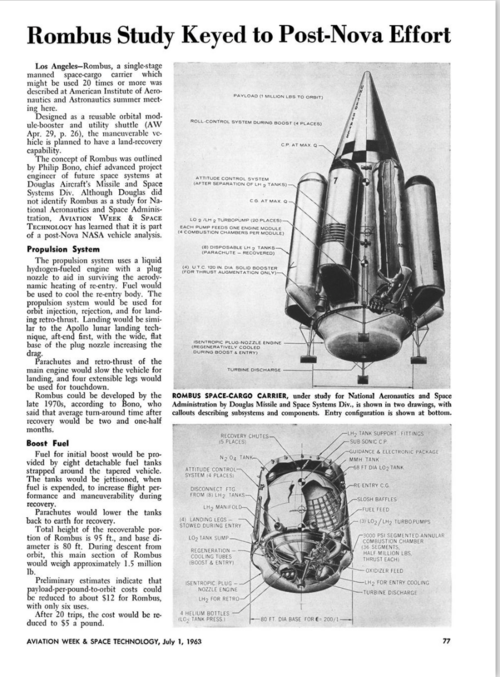- Joined
- 3 June 2006
- Messages
- 3,094
- Reaction score
- 3,951
Philip Bono Collection Images at San Diego Air and Space Museum Archives
Link:
fightingirish said:B)
Philip Bono Collection Images at San Diego Air and Space Museum Archives
Link:


Paul Lloyd said:What shape are the fuel tanks? They look circular in x-section at the top, but then flat at the bottom end.

merriman said:So, all hydrogen was external of the airframe. I assume the two spherical tanks in the plug, near the turbine exhaust, are for the propulsive landing?
What grand plans and glee for the 'new' technology in those long-ago decades. Today, only halting steps (started and abandoned) toward plug/aerospike engines.
Thank god for Rutan, Musk, Bezos, Bond and Branson. They're getting the ball rolling again. Hurray for the privet-sector!
David
Update!!!B)
Philip Bono Collection Images at San Diego Air and Space Museum Archives
Link:

Philip Bono Collection Image
Philip Bono was a renowned space engineer who was probably 30 years before his time. He was born in Brooklyn, NY on January 13, 1921. He graduated from the University of Southern California in 1947 with a B.E. degree in mechanical engineering, and served three years in the U.S. Naval Reserves...www.flickr.com
Silencer1 said:Hello!
I was truly amazed with those projects!
Although, I have some doubt, could it be realized in the proposed spending and time frame?
Those plug nozzles seems, in my humble opinion, to be a unexplored technology, at least requiring extensive testing.
Most of rocket engines till nowadays have been built with more conventional shape of nozzle, don't they?
Mr. Bono offer interesting project, but could it be realized - I'm looking forward to your' opinions, space enthusiasts!
Thanks in advance!
Archibald said:I plan to buy this very book for my coming birthday.
After a few decades of dabbling (both professionally and off the clock) in the area of RLVs, my conclusion is you either go truly fully reusable or not at all. Can you imagine an economically viable airliner with drop tanks? I don't think so, but be my guest.Bezos got my hopes up with his Kankoh Maru type Goddard test craft...I thought he might be the one to bring Bono's work back to life. The last I heard of strap-tanks that could fall away was Wade's early drawing of Angara...how legit that was I don't know. Bono looked at rockets as payloads. Scott had a single shot torus station the print of which I lost to a plumbing disaster..so I hope he posts that here and his rockets of unusual shape. I wonder if you could launch a huge flat plate by having OTRAG pods to either side waterfall off during staging. The few remaining tubes as struts...
Another non viable conceptOTRAG
Silencer1 said:Hello!
I was truly amazed with those projects!
Although, I have some doubt, could it be realized in the proposed spending and time frame?
Those plug nozzles seems, in my humble opinion, to be a unexplored technology, at least requiring extensive testing.
Most of rocket engines till nowadays have been built with more conventional shape of nozzle, don't they?
Mr. Bono offer interesting project, but could it be realized - I'm looking forward to your' opinions, space enthusiasts!
Thanks in advance!
See below. Apparently keeping the "spike" cool is one of the main drawbacks.
I have had a lifelong fascination with Philip Bono’s SSTO designs. It started with a visit in the early 1970’s to Disneyland. There was an attraction called Flight To the Moon and it was sponsored by McDonnell Douglas. Before each “flight” visitors were briefed before Mission Control (inhabited by audio-animatronic people). At one point the visitors were shown the spacecraft they were to fly in-it was a ROMBUS (although it was not called that). Attached is a publicity photo of it.
Which is interesting because Bono's designs feature 'plug-nozzle' engines which double as re-entry heat shields. Can't remember off hand if they were supposed to be actively or passively cooled during re-entry. That said, modern materials might allow for a reappraisal of a passive cooled re-entry approach.
Philip Bono master piece
"Reusable Orbital Module-Booster & Utility Shuttle"from 1964
Encyclopedia Astronautica Index: 1
www.astronautix.com
is SSTO (VTOVL) with payload 450 tons in 185 km Orbit.
with a plug nozzle rocket engine design, used also as heat shield during atmospheric reentry.
most of LH2 fuel is in 8 external tanks (4 drop after 130 sec, 2 after 196 sec, last 2 after 300 seconds)
Variants
Pegasus
SSTO (VTOVL) with payload 90 tons in 185 km Orbit
main use for Pegasus is intercontinental flight !
172 passengers and their luggage from Vandenberg to Singapore in 39 minutes. (the 12,000 km)
Ithacus Sr.
SSTO (VTOVL) with payload 450 tons in 185 km Orbit.
a 1,200 soldier intercontinental troop transporter ! ! !
Encyclopedia Astronautica Index: 1
www.astronautix.com
Ithacus Jr.
SSTO (VTOVL) with payload 33.5 tons in 185 km Orbit.
a 260 soldiers intercontinental troop transporter
(some illustration show lift-off from aircraftcarrier ! )
also proposed Bono to use the ROMBUS for Moon and Mars Mission
refueled in orbit and launch
like Project SELENA (Moon)
or Project DEIMOS (Mars)Encyclopedia Astronautica Index: 1
www.astronautix.com
Encyclopedia Astronautica Index: 1
www.astronautix.com
i Found those model Picture from Douglas
here is its labeled ROMBUS/ITHACUS (Wat make sense because it same size and launch mass.)
but this rocket on right, is on next picture payload of ROMBUS
got some one more detail Info about ROMBUS (in PDF perhaps) ?
and about this picture Payload ?
source of ROMBUS ITHACUS Models

